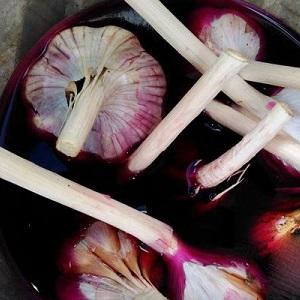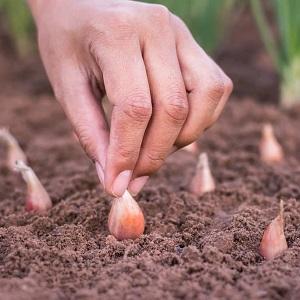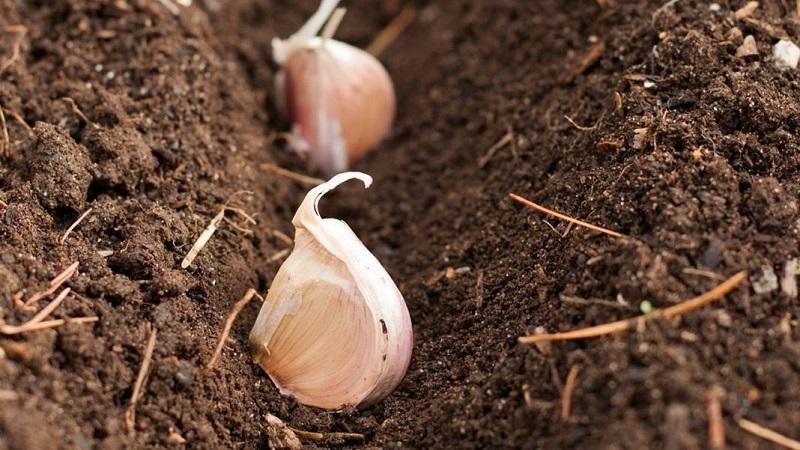We protect the future harvest from pests and diseases - proper processing of garlic before planting
A useful plant like garlic is a relatively unpretentious crop. In some cases, it even grows on its own like a weed, with large heads and a bountiful harvest. But not all gardeners are so lucky. It also happens vice versa - a lot of unsuccessful attempts, resentment and disappointment because of small fruits that rot even after thorough drying. Why is this happening? In most cases, due to elementary mistakes that novice gardeners have heard of.
There are two types of garlic, which differ in terms of planting teeth in open ground and harvest time. Spring garlic is planted in early spring and ripens in late summer. The winter variety is planted in the fall, and the harvest is harvested in July.
The heads of spring garlic are smaller, but store better. The teeth in the winter bulb are located around the trunk, and in the spring bulb, in a chaotic manner. Winter garlic is very popular with gardeners, but some prefer spring varieties. To get a high-quality long-stored crop with large heads, it is important to follow the simple rules for preparing garlic for planting in spring or autumn.
The content of the article
Processing spring garlic before planting
These varieties of garlic are among the first crops to be planted early outdoors.... Determining the optimal planting time is simple: as soon as the snow has melted and the frost has stopped, wait for clear weather.

The soil should warm up well in the sun during the day, but not dry out... Moisture from melted snow, vital for future crops, should remain in the soil. In temperate climates, spring garlic is planted around mid-April. An air temperature of + 5 ° C and above will contribute to the active growth of crops.
How does the preparation for planting spring garlic begin? First, you should inspect and select suitable bulbs, then prepare the cloves for planting... Before planting in the ground, it is imperative to disinfect the planting material. This guarantees a high-quality harvest that will not be affected by pests or diseases during the growth process.
Garlic is disinfected in the following ways:
- process the teeth with copper sulfate;
- use a solution of wood ash;
- soak for a short time (for 3-4 minutes) in a solution of sodium chloride;
- disinfect with ash liquor;
- pickle with Fitosporin.
We will consider each stage in more detail below.
Selection and preparation of cloves
How to prepare garlic for planting? The process begins with a visual inspection of the selected heads... For sowing, it is recommended to use the harvest of the previous year. We select the best and largest healthy bulbs. Species with bluish or pinkish hulls are preferred. Not overdried will germinate faster.
Important! The heads must be clean with no signs of rot or any damage.
Spring garlic is planted as separate prongs, and whole heads. For planting, it is better to use varieties that correspond to certain climatic conditions.
The teeth are taken and separated from the head just before planting, otherwise you can dry out the bottoms, which will significantly delay the seedlings. We carefully separate each element from the head. It is important that there is no damage to the husk, the lower and upper edge of the tooth. If a large onion is caught, but the cloves in it are small, it is better not to use such material for sowing.
The next step is calibration... We sort through the teeth and sort them by size (we will plant in the same way).
Soil preparation - we put the site in order
One of the factors that invariably affect the quality of the crop, - a competent choice of location and proper preparation of the beds. It is best to plant garlic after crops such as cabbage, peas, and squash. Agronomists advise against planting it after turnips, carrots and spices.
There are two ways soil preparation for planting spring garlic in spring:
- Soil preparation in the fall. With autumn digging, a compost solution (in a proportion of 10 liters per 1 sq. M of the garden), wood ash (1 kg per 1 sq. M) and double superphosphate (10 g per 1 sq. M) are added to the soil to the area chosen for garlic.
- Spring preparation of the beds. With spring deep loosening of the soil, humic fertilizers (10 liters of solution per 1 sq. M of the garden) with wood ash (1 kg per 1 sq. M) and "Azofoskoy" (1.5 tablespoons per 1 sq. M) are added to the soil ).
 Another option for spring tillage before plantings - well-rotted manure in combination with wood ash (10 kg of humus and 3 st. ash per 1 sq. m).
Another option for spring tillage before plantings - well-rotted manure in combination with wood ash (10 kg of humus and 3 st. ash per 1 sq. m).
How to use fertilizers correctly? It does not matter whether in winter or autumn, the earth must be dug up on one shovel bayonet, fertilized and formed a bed. Then carefully loosen the soil and level it.
Reference.In some cases, the garden bed is raised 10-15 cm above the level of the garden. For better moisture retention, a small side of black soil is made around the perimeter of the garden.
Before planting crops in the spring, it is advisable to disinfect the soil against possible viruses and pests with a weak saline solution. Dissolve 60 g of salt in a bucket of water and soak the garden bed.
Processing of spring garlic from pests and diseases
Dressing garlic from diseases and pests before planting - the most important and obligatory stage. We process the teeth just before planting in the ground. First, decide in what way it is better to process the planting material, prepare the necessary ingredients and follow the further instructions.
Read more:
Top 30 best varieties of garlic
Soaking in a solution of wood ash
This method helps to accelerate the emergence of spring garlic... It is better not to soak winter varieties in such a solution before planting. It is recommended to keep the garlic in the refrigerator for about 30 days before processing.
For the solution, pour 2 glasses of ash with 2 liters of hot water... We are waiting for the solution to cool and the mixture is stratified. We pour the light top layer of the mixture into a separate container and soak the prepared planting material in it. After an hour, we remove the teeth, dry them and plant them in the ground.
Copper sulfate treatment of cloves
Copper sulfate is a universal disinfectant for plant crops. A 1% solution of the substance is used to process the cloves of garlic.
There are two ways:
- We soak the planting material for 3 minutes in the solution. Then we remove, dry the teeth and plant them in the garden.
- The more correct way of processing garlic is considered in two stages. First, we keep the material for a couple of minutes in a solution of table salt (3 tablespoons per 5 liters of water), this is necessary for additional disinfection. Then half an hour in copper sulfate (1 tsp substance in a bucket of water).
For the prevention of fungal infections, copper sulfate is used for already germinated crops... The solution is made in about the same way as for pre-sowing treatment, but in addition 1 tbsp is added to it. l. crushed 72% laundry soap.
Soaking garlic in a solution of potassium permanganate
 Processing garlic with potassium permanganate before planting implies soaking the teeth in a weak solution for 12 hours.
Processing garlic with potassium permanganate before planting implies soaking the teeth in a weak solution for 12 hours.
Also, with potassium permanganate, complex processing is performed:
- The first stage is the soaking of the seed in a solution of "Nitroammofoski" (1 tbsp. L. Substance per bucket of water). The teeth should be in it for a day.
- Then the teeth are kept in a weak saline solution for 20 minutes.
- The final stage is a 20-minute processing of the material with a 1% solution of copper sulfate.
Disinfection with "Fitosporin"
The drug is based on the action of beneficial bacteriathat destroy harmful microorganisms and fungal infections.
We prepare the solution according to the instructions on the package and keep the cloves of garlic in it from half an hour to an hour. Then the same composition can be used to process the beds before planting.
Fitosporin-M improves crop growth and has a tonic property.
Processing garlic before planting in a saline solution
This approach destroys possible fungal infections and any pathogenic bacteria.
Immediately before planting, soak for 3 minutes inoculum in saline (6 tablespoons per 10 liters of water). We plant the teeth in the ground immediately after removing from the solution, without washing or drying.
Ash liquor disinfection
Ash liquor is the same solution of wood ash... In addition to disinfecting the teeth, it also serves as a mineral fertilizer, which has a positive effect on crop growth.
Prepare a solution of ash liquor with the same proportions as a solution of ash... The only difference is keeping it on low heat for at least half an hour. In the top layer of the mixture, poured into a separate container, soak the garlic for an hour.
There is another way to prepare the product. and material handling. We sift 1.5 kg of ash several times to remove large fragments. Add the sifted material to boiling water (5 l) and bring the mixture to a boil. Before soaking the garlic, dilute the resulting cloudy liquid with plain water about 1: 1. In such a solution, we keep the garlic for at least 20 minutes.
Read more:
How to prepare a garden for planting garlic before winter
 Planting winter garlic differs from the spring variety in thatthat the first species is planted in late autumn, preventing its early shoots.
Planting winter garlic differs from the spring variety in thatthat the first species is planted in late autumn, preventing its early shoots.
First, we choose a site for the future garden... It is desirable that the place is elevated and receives a lot of sunlight. The main criterion for choosing a site is that melt and rain water does not stagnate on it. If you choose an area where the sun is almost out, the crop will be pale and shallow.
You can choose the area where legumes grew (beans, batter), zucchini, cucumbers, cabbage, etc.
Digging a garden means adding fertilizers.
Attention!Do not add fresh manure to the soil. It will provoke deformation of the forming head and entail a significant loss of yield.
It is best to treat the soil before planting winter garlic with potassium salt with superphosphate.... You can also sprinkle already formed beds with wood ash.
Dug and leveled beds need pour water well.
A prerequisite for planting winter garlic is soil disinfection... The procedure is performed before planting the planting material in two stages. Before planting the culture, we spill the prepared bed with a weak solution of copper or iron sulfate, calculating half a bucket per 1 sq. m.
The second time, we treat the soil with nitrogen fertilizer with urea in 24 hours before the scheduled landing. Dissolve the substance in water or scatter it dry, but after that we must water it. The approximate consumption of funds is 15-16 g per 1 sq. m.
Important!After processing the soil with dry fertilizer, be sure to water the garden bed before planting so that the product dissolves and gives the soil useful minerals. The dry product can burn the seedlings.
How to process garlic before planting before winter
Before processing, the planting material must be selected... As in the case of spring garlic, the heads must be examined for damage, the largest ones must be selected. Shortly before planting, divide into slices, choosing the largest.
Attention!If the head consists of 3 or 4 teeth (although they are large), then it is better not to take such material for planting. This is a sure sign that the culture is beginning to degenerate.
If there is more than enough planting material, we choose the largest teeth for planting.... If there is not enough garlic, we calibrate - sort the cloves by size and then plant them in groups. This approach will give more uniform seedlings and, accordingly, a harvest.
Garlic cloves should not be damaged on the husk and bottom... You should not select wet teeth for planting, as this will provoke the earliest seedlings of the culture. Before winter, this is completely unnecessary, since the plants will simply freeze.
To prevent the garlic from rotting in the ground, we process the cloves immediately before planting in the ground.

How to process garlic? We do it in the following ways:
- We soak the teeth for 10 hours in a 1% solution of copper sulfate. It is more convenient to do this in the evening before the morning landing.
- We also process winter garlic before planting in stages in three solutions: soak for a day in Nitroammofosk (1 tablespoon per bucket of water), for 20 minutes in a salt solution (10 tablespoons per bucket of liquid) and for a minute in copper sulfate (proportions are the same as with "Nitroammofoska") just before disembarkation.
- For processing winter garlic, you can use the drug "Maxim". Its difference is that, having a completely natural origin, it serves as a kind of antibiotic and acts throughout the entire period of growth and development of the culture. We dilute an ampoule of the product in 1 liter of water and place the planting material there for half an hour. After use, the solution can be poured onto the garden bed before planting.
- We process winter garlic and wood ash solution. The recipe for the preparation of the substance and the principle of processing do not differ from spring garlic.
- You can disinfect the planting material in a saline solution by placing the teeth there for 1-2 minutes before planting, then for a minute in a solution of copper sulfate.
- The drug "Fitolavin" will protect against damage by various infections and protect the plant from possible root rot and fungus. The substance is highly effective and can cure even diseased plants. The rules for using the substance are indicated in the instructions on the package for each specific case.
- Treatment with a slightly boring solution of potassium permanganate. Place the seedlings in the solution for an hour before planting.
- Another option is to process winter garlic with Fitosporin. The proportions of the substance dilution and the processing time are completely identical to the variant with the spring crop variety.
Proper processing of garlic in the fall will enable the plant to develop normally. and please the owner with a bountiful harvest by summer.
Do I need to peel winter garlic before planting in the garden?
Garlic hulls are natural defense against pests and infections... It is not necessary to remove it in any case. First, the plant will be unprotected. Secondly, you can accidentally damage the base of the prong, and the seedling will not be able to germinate.
After what crops is it best to plant garlic
 Winter and spring garlic will yield bountiful harvests if you choose the right place to plant... In addition to the fact that it is advisable to make the bed on a hill and with free access to the sun's rays, it is extremely important that it previously grew in the chosen place.
Winter and spring garlic will yield bountiful harvests if you choose the right place to plant... In addition to the fact that it is advisable to make the bed on a hill and with free access to the sun's rays, it is extremely important that it previously grew in the chosen place.
A good harvest of garlic will be if the crop is planted after:
- siderates;
- squash and pumpkin;
- cucumbers and zucchini;
- 40-day potatoes;
- early and cauliflower;
- peas, beans and beans.
It is highly undesirable to plant garlic if in the chosen place grew carrots, turnips, herbs and spices.
Neutral cultures:
- late cabbage;
- pepper;
- tomatoes;
- garlic;
- beet;
- eggplant;
- onion.
Outcome
Properly preparing garlic for planting is half the battle on the way to a bountiful harvest. All stages are important - from the choice of the place to the necessary treatment of plants with fertilizers, natural antibiotics and useful minerals. You will find some more important tips for preparing garlic before planting in the video.